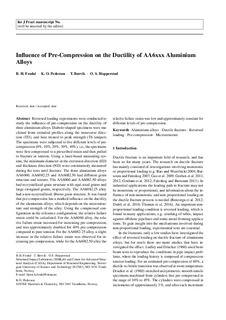| dc.description.abstract | Reversed loading experiments were conducted to study the influence of pre-compression on the ductility of three aluminium alloys. Diabolo-shaped specimens were machined from extruded profiles along the transverse direction, and heat treated to peak strength (T6 temper). The specimens were subjected to five different levels of pre-compression (0, 10, 20, 30, 40%), i.e., the specimens were first compressed to a prescribed strain and then pulled to fracture in tension. Using a laser-based measuring system, the minimum diameter in the extrusion direction and thickness direction were continuously measured during the tests until fracture. The three aluminium alloys AA6060, AA6082.25 and AA6082.50 had different grain structure and texture. The AA6060 and AA6082.50 alloys had recrystallized grain structure with equi-axed grains and large elongated grains, respectively. The AA6082.25 alloy had a non-recrystallized, fibrous grain structure. It was found that pre-compression has a marked influence on the ductility of the aluminium alloys, which depends on the microstructure and strength of the alloy. Using the compressed configuration as the reference configuration, the relative failure strain could be calculated. For the AA6060 alloy, the relative failure strain increased for increasing pre-compression, and was approximately doubled for 40% pre-compression compared to pure tension. For the AA6082.25 alloy, a slight increase in the relative failure strain was observed for increasing pre-compression, while for the AA6082.50 alloy the relative failure strain was low and approximately constant for different levels of pre-compression. | nb_NO |
